#late baroque fashion
Explore tagged Tumblr posts
Text
Some post Louis XIV fashion -
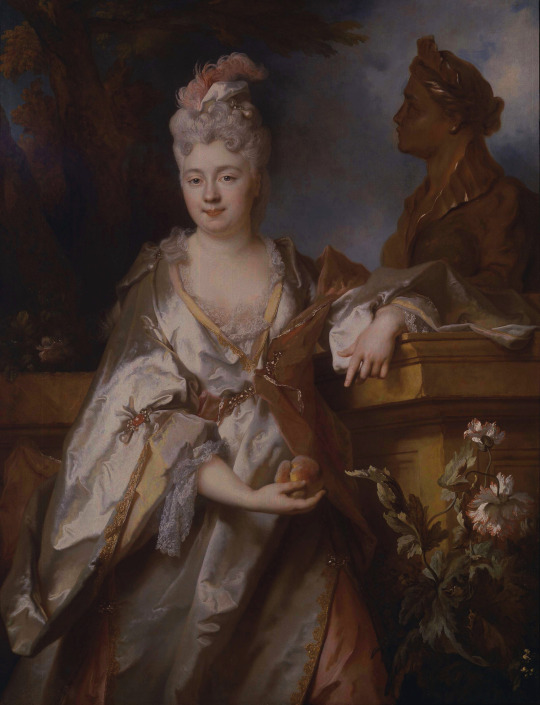
1715 Jeanne-Cecil Le Guay de Montgermon, three quarter length in a white satin robe with gold trimming and a ruby and pearl brooch by Nicolas de Largillière (Robilant & Voena, specific location ?). From their Web site; From their Web site; fixed spots in background with Photoshop and increased color saturation. 2721X3532.

1716 Mary Josephine Drummond, condesa de Castelblanco by Jean Baptiste Oudry (Museo del Prado - Madrid, Spain). From their Web site;fixed spots w Pshop 2045X2717.

ca. 1715 Louise Adélaïde de Bourbon by Pierre Gobert (Châteaux de Versailles et de Trianon - Versailles, Île-de-France, France) photo - Gérard Blot. From Réunion des Musées nationaux; enlarged by half 726X956.

ca. 1715 Sarah Lascelles (1656/1659–1743), Mrs Joshua Iremonger II, then Mrs Christopher Lethieullier by Michael Dahl I (Uppark House and Garden - South Harting, Petersfield, West Sussex, UK). From bbc.co (now artuk.org) 652X800.
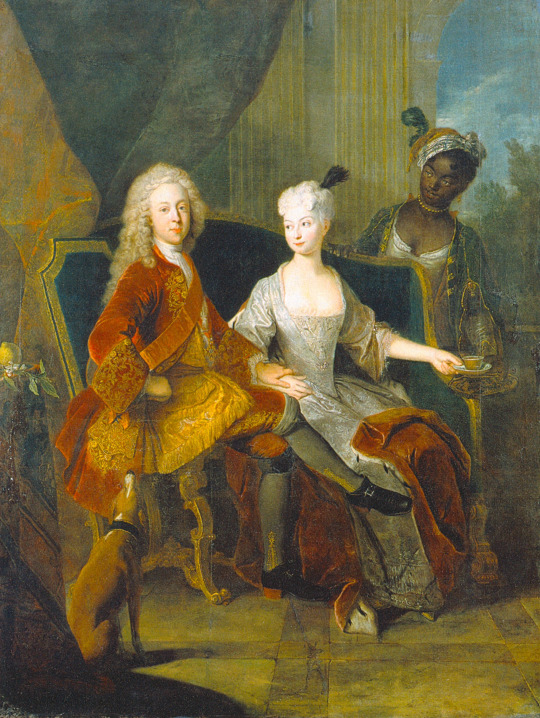
ca. 1716 Friedrich Ludwig of Württemberg and his wife Henriette Marie of Brandenburg-Schwedt by Antoine Pesne (Staatliches Museum Schwerin - Schwerin, Mecklenburg-Vorpommern, Germany). From Wikimedia; removed spots and linear and splotch flaws with. Photoshop 2078X2763.
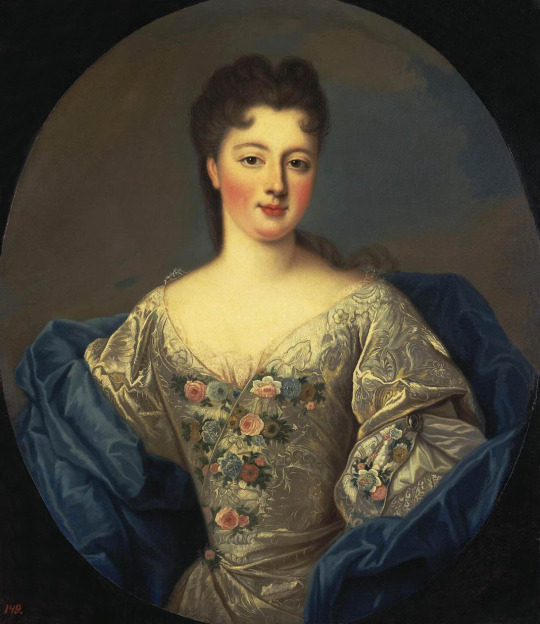
ca. 1716 Marie Louise Adélaïde d'Orléans the future Abbess of Chelles, daughter of the Regent of France by Pierre Gobert (Domaine de Sceaux - Sceaux, Hauts-de-Seine, Île-de-France, France). From Wikimedia; fixed spots w Pshop 1069X1235.

ca. 1717 Madame de Ventadour by Pierre Mignard (Châteaux de Versailles et de Trianon - Versailles, Île-de-France, France). From Wikimedia 1516X2000.The abundant lace ruffles on her sleeves point to the future while the headdress looks back to Fontanges and cleft coiffures.

Lady, said to be Marie-Elisabeth Le Fèvre de Caumartin (d. 1717) by Nicolas de Largillière (Sotheby's - 13Jun07 auction Lot 56). From their Web site; fixed obvious spots & cracks w Pshop 2396X2866.
#1710s fashion#late Baroque fashion#Rococo fashion#Georgian fashion#Louis XV fashion#Nicolas de Largillière#Jean Baptiste Oudry#Michael Dahl#Antoine Pesne#Pierre Gobert#Pierre Mignard
6 notes
·
View notes
Text
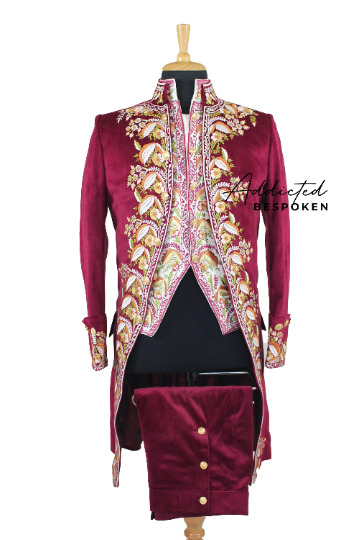
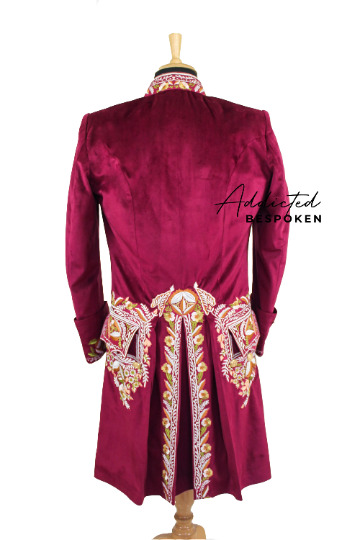

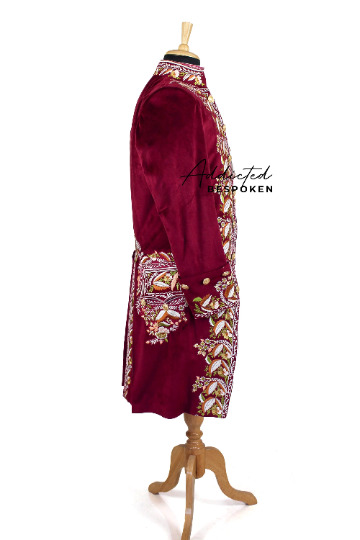
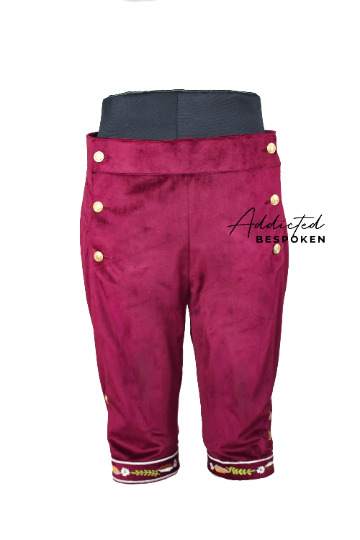

Men Red Velvet 3Pc Fersen Court Suit Period Clothing Floral Embroidered Metallic Detailings French Nobleman Costume Free Lace Jabots & Cuffs
This 18th Century vintage costume for men is inspired from the magical Venical Carnival & Late Baroque fashion. The costume can become the zest of any carnival or themed festival and can also be a perfect costume for wedding groom.
This 3Pc court suit include: •Red velvet justaucorps embellished with Victorian floral embroidery & metal button detailing •Off white paisley print vest embellished with Victorian floral embroidery & have metal buttons closure •Red velvet Breeches with floral embroidery on bottom & metal button detailings & closure •Laced jabots & cuffs
Features: •Intricate embroidered •Lightweight •Soft & Breathable •Comfortable wearing in all seasons
Material & Caring: •Premium Velvet & Eco friendly material •Dry Clean •Dry on low heat or hang to dry for best result
#men period clothing#carnival costumes#masquerade costumes#venetian costume#18th century fashion#1780's men costume#vintage clothing#colonial costumes#men rococo costume#late baroque fashion#fersen court suit#french court suit#frock court suit
2 notes
·
View notes
Text
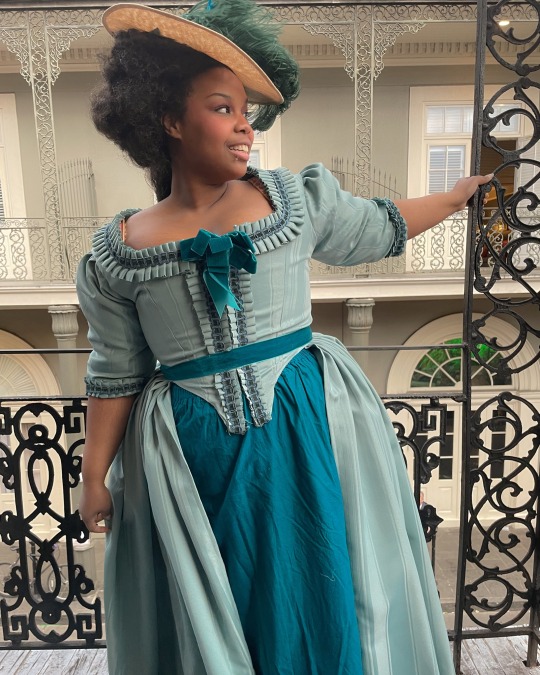
from this post
#rococo#late baroque#historical fashion#historical costuming#historical costume#1780s#18th century#18th century costume#teal aesthetic#black people in period clothing#black people in historical costume#mignonne#2023#blue
2K notes
·
View notes
Text
The Birth of Charles II of Spain Fanart

Warning: This story contains some artistic license
The Queen's pregnancy was approaching its end and had become a matter of utmost importance. The future of the Monarchy depended on this event. On Sunday, November 6, everything seemed to be ready. The doctors and physicians were on alert; the Queen's confessor was near her, and the Chief Steward of her Household was carefully reviewing the arrangement of the items in the birth chamber. To guarantee the success of the event, all the holy relics that were in the Palace and others brought from El Escorial and other places had been arranged in order. There was the staff of Saint Dominic of Silos that the Order of Saint Dominic had brought, the ribbon of Saint John Ortega, from the Order of the Hieronymites; the incorrupt bodies of Saint Isidore and Saint Diego de Alcalá; the image of the Virgin of Solitude and the one so venerated by the royal family, Our Lady of Atocha. It is not easy to find a space so holy and sacred. Everything, then, was ready, the things of the earth arranged to implore God's pleasure. At noon, after a frugal lunch, Philip IV retired to his chambers. At the same time, While eating, Queen Mariana suddenly felt intense pain in her abdomen, realizing that she was about to give birth. She quickly left the table and hurried to the Tower Chamber.
King Philip went straight to his study while looking at Prospero’s portraits. He entered his study, sat down, and began to write to answer the last letter of Sor Maria de Agreda. He wrote with a deep sigh and tears in his eyes.
“ With the long illness of my son, and the continuous help I was giving in his room, I have not answered your letter of the last month...I assure you that what has most exhausted me, more than this loss, is to see clearly that I have vexed God and he sent this punishment to castigate my sins...
(The king reminisces his cherished memories with Felipe Prospero while writing this letter)
Help me as a friend with your prayers to placate God’s just anger and beg Our Lord that, as he took my son from me, He may make his light shine on the Queen, whose confinement we await hourly, and give her good health and guard what is to be born, if his will, for otherwise I do not wish it...
Back in the Tower Chamber, Queen Mariana cries in agony as she is delivering her baby. The royal midwife Ines Ayala told Queen Mariana to push harder. Five other doctors were present at this event in case of emergency. One of those doctors was Dr Bravo. While the Queen was giving birth, the courtiers and Infanta Margarita looked on.
Ah, Sor Maria, If I had succeeded in following your teachings, perhaps I would not have found myself thus. Pray to our Lord that he may open his eyes, that I may perform his holy will in all things... There is nothing new in the English situation. I, thank God am in good health...
At this point, King Philip was interrupted by a courtier who delivered the news and told the events occurring in the Tower Chamber. King Philip was anxious about the future that lay within a few hours. He prayed heavily to God, asking him to deliver him a son. All could imagine the impatience of the Royal Court of Madrid and Europe, waiting for an outcome of this event. As hours passed, Queen Mariana was still in labor, and the doctors argued over natural forms of treatment. They were anxious as the Queen and the child’s life was at stake.
Dr. Bravo proposed a theory: In the past, Queen Mariana had difficult experiences giving birth to her children. At the birth of Maria Ambrosia, Felipe Prospero, and Fernando Tomas, The Queen had terrible epileptic seizures, and the infants died or lived for a short time. On the other hand, at the birth of Infanta Margarita, the only child to survive, The Queen had been perfectly well. Now why was this? The reason is simple: Just before Infanta Margarita was born, Queen Mariana had suffered several violent nosebleeds. Therefore, what she requires now is to be bled.
Some doctors disagreed, warning that the proposed action could endanger the Queen and her child. Concerned, Queen Mariana asked the doctors if there were any alternative procedures. The doctors offered different opinions, while Dr. Bravo defended his proposal. As the debate continued, Mariana went into labor with the assistance of Ines Ayala. The infant cries and is alive. The birth of the infant brought joy to all. King Philip became a father once again. When the courtier informed King Philip of the birth, he was overjoyed and immediately visited the tower chamber to see his newborn son. King Philip joyfully held his son and proudly showed him to the Queen and his daughter. When the courtier informed King Philip of the birth, he was delighted and immediately visited the tower chamber to see his newborn son. King Philip joyfully held his newborn son and showed him to the Queen and his daughter.
Sources:
Carlos, A king who would not die by John Langdon Davis
Happy Birthday, Charles II of Spain!
#all I did is just combine these stories together#history#mariana de austria#spain#art#charles ii of spain#house of habsburg#17th century#habsburg#carlos ii#please like and reblog#my art#Mariana's art#happy late birthday#sorry it took me so long#my cute baby#margarita#margarita maria#philip iv#look at them#i love them so much#they are so cute#espana#kingdom of spain#madrid spain#monarquía española#spanish empire#baroque fashion#baroque#artists on tumblr
64 notes
·
View notes
Text
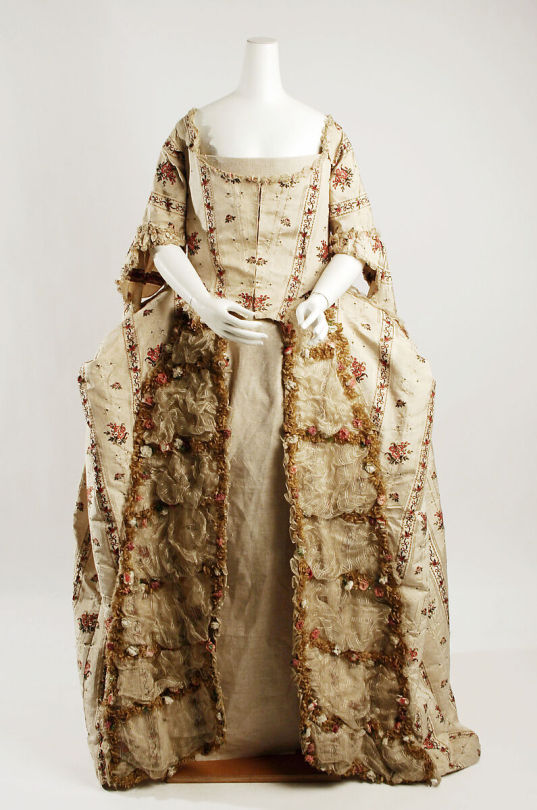

Robe à la française, c. 1760-70
#history#art history#fashion history#baroque#rococo#antique#romantic academia#light academia#light acadamia aesthetic#romantic academia aesthetic#18th century#late 18th century#1700s#late 1700s#french#silk
36 notes
·
View notes
Text

Robe à la Française - 1770-75 (Rococo)
A staple of 18th Century (1700- 1799 C.E.) aristocratic and monarchic fashion; adapted from the Mantua (Late 17th Century) and Robe Volante. Fashionable between circa 1720 - 1780.
'Robe à la Française' were only second to court dress in formal wear, it is characterized by the impish and coquettish opulence of the Rococo/Late Baroque movement. The 'Robe à la Française' also known as a 'Sack Gown' or 'French Gown' was fitted in the front with a robe a top of the petticoat layer with a decorative stomacher going under the lace of the stays - covering the chemise; whilst the back had loose Watteau (box) pleats.
#robe a la francaise#Saque Gown#French Gown#rococo#18th century#Late Baroque#fashion history#french#1770's
9 notes
·
View notes
Note
There is no way to say it pleasantly. Your recent post about Julie... its speculation is a slap in the face of masculine women. Dressing in men's clothing is not a statement against being female, especially in times when male clothes were far more practical than women's. (And especially in the case of a bisexual or homosexual woman!) Behaving "unwomanly" is evidence only in the eyes of sexists. But even today... it is stunning to think that a woman, should her every thought not be recorded, could be deemed a secret man for being masculine! That lingering speculation, despite absence of proof, is rather insulting.
Your reading of my post is extremely dishonest or you didn't actually read the post. The whole time I talk about her as a sapphic woman, because that is what the evidence most point towards. If you think even raising the possibility that she might have been somewhere in the genderqueer or trans spectrum (like some butch lesbians identify as genderqueer and/or trans too), is an insult and means I'm sexist or some shit, there's no way to say it pleasantly, you're probably just a fucking terf.
Now I have no illusions that correcting some of the inaccurate things you said will do anything to change your mind, but because we're already here and I'm allergic to these bad fashion history takes, I'll correct them anyways. This is more for anyone else who happens to see this and actually has some level of reading comprehension.
The women's dress at the time was not necessarily any more impractical than the men's dress. The impractical part of high society women's dress was the skirt that usually had a large trail. But they would also have much more practical dresses for casual usage. High society men wore large wigs that were I would assume pretty impractical. Their clothing, which was well fitted around the torso, closed with buttons and then not very easily adjustable. On the other hand the women's dress was either loose and pinned and belted to fit (in the case of mantua) or laced (in the case of rigid gown) so very easily adjustable even during the day to keep it comfortably fitted to the changes in the body. This would be more practical for anyone, but especially to most afab people, whose bodies can change quite drastically thorough the month.



My point is actually no Julie de Maupin did not have any practical reason to dress in men's clothing. In fact it was impractical for her. As I point out in the post she struggled with the leading female roles, which she wanted to get, partly because her off-stage personality clashed so much with them. (At first) she didn't get as much recognition of performances in leading roles as in supportive roles, partly because the audiences had trouble buying her performances in those roles.
And the other point. The modern concept of fashion doesn't entirely apply to the past. Now fashion is seen as self-expression. Even being into fashion is seen as an indication of certain personality. This was not the case in the time when Julie was alive. Back then fashion was much more social decorum. To be able to participate in the high society you had to keep up with fashion. There were people who were more fashionable than others, sure but they were mostly just the richest young people around, and that made them most fashionable. Fashion was not for self-expression, it was mostly for expression of hierarchy. It was also for political expression. (There's an interesting paper on the contemporary commentary of the politics of the court fashions, which I will link here, when I'm on my desktop.) It was not about what you wanted to wear, but what you wanted others to think about you.
In addition to that at the time clothing was integral part of gender (arguably still is judging from all the conservatives loosing their minds when a man dares to wear a dress). Women in breeches and men in skirts were seen as transgressing on gender. This can be seen even in the mid 1600s conservative reaction to when women's riding habit first appeared (they never change do they?). They complained that the women were basically indistinguishable from young pretty men and like the women were even wearing skirts (seen below)? Part of this was that both the women and men were shaping their silhouettes with their clothing to gain the fashionable feminine and masculine silhouettes, which meant that different shaped bodies could still achieve either silhouette.

Looking through this lens we can ask, why did Julie wanted to be seen as transgressing on gender even though it hindered her career? I think there could be many answers to this question and one could be that she wanted to be seen as not-woman (or maybe not entirely woman). We can never know, because we don't have any of her thoughts about her androgynous expression surviving to this day.
#sorry but like you didn't take me at good faith so i won't take you either#answers#fashion history#historical fashion#queer history#late baroque#julie d'aubigny#julie de maupin#anon
134 notes
·
View notes
Text

painting at chattsworth house, UK
#cottagecore#vintage#fairy aesthetic#cottage aesthetic#edwardian#flowers#gardens#regency#rococo#1700s#late 1700s#1700s fashion#18th century#1700s art#georgian#1830s#historical art#fashion history#1600s#1600s art#baroque#17th century#19th century art
4 notes
·
View notes
Text
more words for characterization (pt. 4)
Age
adolescent, afresh, ancient, antiquarian, antique, big, childish, crude, doddering, elderly, fresh, full-grown/full-fledged, green, hoary, immemorial, infant/infantile, junior, late, medieval, mint, modish, new, novel, older, old-fashioned, originally, outdated/out-of-date, passé, quaint, refreshing, secondhand, stale, state-of-the-art, undeveloped, up-to-date, well-preserved, youthful
Appearance
adorable, aesthetic/esthetic, artistic, beautiful, comely, crisp, dapper, decorative, desirable, dressy, exquisite, eye-catching, fancy, fetching, flawless, glorious, good-looking, graceful, grungy, hideous, homely, irresistible, natty, ornate, plain, pretty, refreshing, resplendent, seductive, spiffy, striking, stylish, ugly, unbecoming, willowy, with-it
Genuineness
abstract, actually, alias, apocryphal, apparently, arty, authentic, baseless, beta, bona fide, circumstantial, concrete, contrived, credible, deceptive, delusive, dreamy, ecclesiastical, empirical/empiric, enigmatic/enigmatical, ersatz, ethereal, factual, fallacious, fantastic, far-fetched, fictitious, foolproof, fraudulent, good, hard, historical, honest-to-God, illusory/illusive, imitative, indisputable, invisible, just, lifelike, made-up, magic/magical, make-believe, matter-of-fact, metaphysical, monstrous, mystic/mystical, mythical/mythological, nonexistent, openhearted, ostensibly, paranormal, physical, positive, pretended, quack, quite, realistic, right, sincerely, specious, spurious, supernatural, synthetic, tangible, true, unearthly, unnatural, unthinkable, unvarnished, unworldly, valid, veritable, wholehearted/whole-hearted, wrong
Movement
ambulatory, brisk, clumsy, fleet, fluent, frozen, gawky, graceless, immobile, indolent, itinerant, leisurely, lifeless, liquid, lithe, maladroit, migrant/migratory, motionless, moving, nomadic, oafish, passive, pendulous/pendent, portable, restless, roundabout, sedentary, slow, speedy, static, vibrant, winding
Style
adorable, baroque, becoming, black, bold, brassy, cheap, class, classy, contemporary, country, cultural, dashing, dowdy, eat high on the hog, exquisite, featureless, flamboyant, floral, flowery, formless, futuristic, garish, gay, glamorous, gorgeous, grand, graphic, hot, improvised, informal, innovative, kinky, loud, lush, luxurious, mean, meretricious, modish, neat, new, obsolete, old-fashioned, orderly, ornamental, ostentatious, outdated/out-of-date, palatial, picturesque, plush, posh, prevalent, quaint, refined, resplendent, rustic, scruffy, sharp, simple, sleazy, smart, snazzy, spiffy, spruce, stately, state-of-the-art, stylish, swank/swanky, tacky, tasteless, tousled, two-bit, unbecoming, unworldly, up-to-date, vogue
NOTE
The above are concepts classified according to subject and usage. It not only helps writers and thinkers to organize their ideas but leads them from those very ideas to the words that can best express them.
It was, in part, created to turn an idea into a specific word. By linking together the main entries that share similar concepts, the index makes possible creative semantic connections between words in our language, stimulating thought and broadening vocabulary. Writing Resources PDFs
Source ⚜ Writing Basics & Refreshers ⚜ On Vocabulary
#character development#vocabulary#langblr#writeblr#writing reference#spilled ink#creative writing#dark academia#setting#writers on tumblr#poets on tumblr#poetry#literature#writing tips#writing prompt#writing#words#lit#studyblr#fiction#light academia#characterization#writing resources
4K notes
·
View notes
Text
15th century (Houppelande the Ritz)

Early 16th century (God please, not the codpiece)

Late 16th/early 17th centuries (That's ruff, buddy)

Mid-17th/early 18th century (If it ain't Baroque, fix it)

Mid-18th century (Big tent party)

Late 18th/early 19th century (Empire state of mind)

Mid-19th century (Hoop springs eternal)

Late 19th-early 20th century (Hustle and bustle)

1910-20s (Ankles aweigh)

#yes the divisions are wonky don't @ me#as for the puns I can only apologize#fashion history#hot takes
1K notes
·
View notes
Text
Basically who I am inside: a timid pale and fragile Victorian girl
Two-part evening dress, Maison Clergeat, Paris, 1898-1900



Silk satin called “Charmeuse”, wool and sequin embroidery, lace flounce, muslin, taffeta lining. Gift of Madame Solange Granet, in memory of her cousin, Madame Montaudon, née Le Grain-Eiffel.
#la belle époque#la belle et la bête#la belle personne#le fantome de l'opera#palais garnier#victorian era#19th century#1800s#fashion history#late victorian#victorian fashion#historical fashion#late 1800s#1800s fashion#1860s#victorian aesthetic#victorian gothic#baroque#pachelbel#george frideric handel#henry purcell#johan sebastian bach#sherlock holmes#sherlock fandom#baker street#tale of two cities#paris opera house#christine daae#erik destler#wedding dress
367 notes
·
View notes
Text
Early 18th (and late 17th) century fashions are so under-utilized in vampire media and I think it's a damn shame.
I don't actually think I've ever seen a single image of a vampire character in an early 18th century suit. Hardly any movies set in that era either, and hardly any historical costumers who do it. (Even my beloved gay pirate show set in 1717 takes nearly all of its 18th century looks from the second half of the century. Not enough appreciation for baroque fashion!!)
Yes I love late 18th century fashion as much as anyone, and 19th century formal suits are all very well and good, but if you want something that says old, dead, wealthy, and slightly dishevelled, then the 1690's-1730's are where it's at.
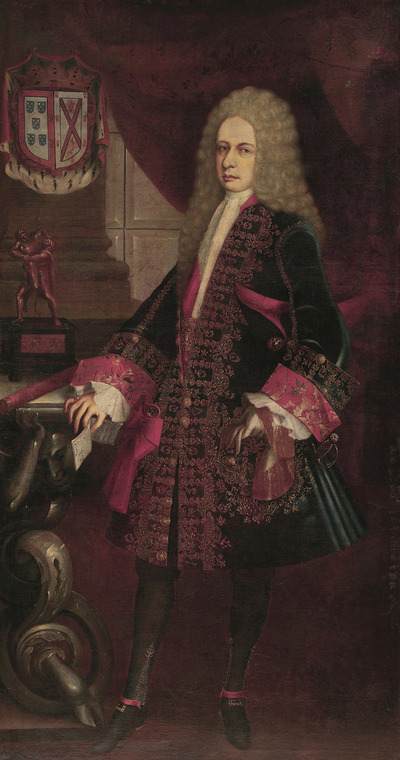
(Retrato del Virrey Alencastre Noroña y Silva, Duque de Linares, ca. 1711-1723.)
There was so much dark velvet, and so many little metallic buttons & buttonholes. Blood red linings were VERY fashionable in this era, no matter what the colour of the rest of the suit was.
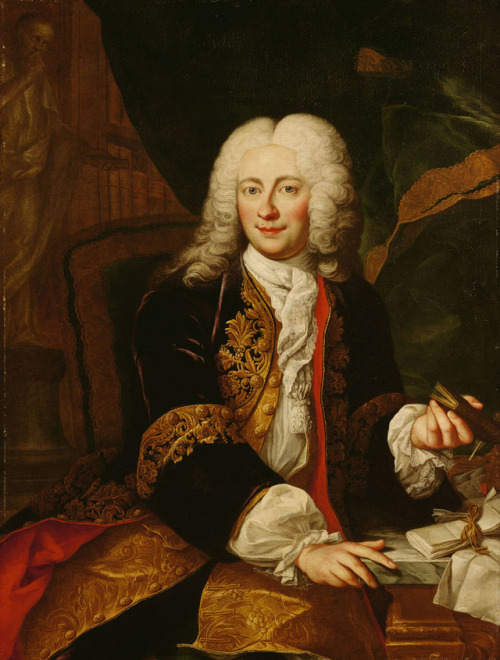
(Johann Christoph Freiherr von Bartenstein by Martin van Meytens the Younger, 1730's.)
The slits on the front of the shirts are super low, they button only at the collar, and it's fashionable to leave most of the waistcoat unbuttoned so the shirt sticks out, as seen in the above portraits.

(Portrait of Anne Louis Goislard de Montsabert, Comte de Richbourg-le-Toureil, 1734.)
Waistcoats are very long, coats are very full, and the cuffs are huge. But the sleeves are on the shorter side to show off more of that shirt, and the ruffles if it has them! Creepy undead hands with long nails would sit so nicely under those ruffles.
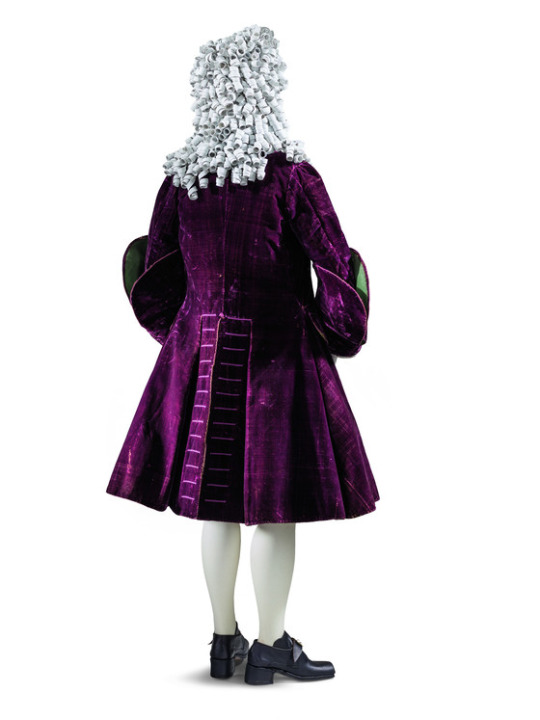
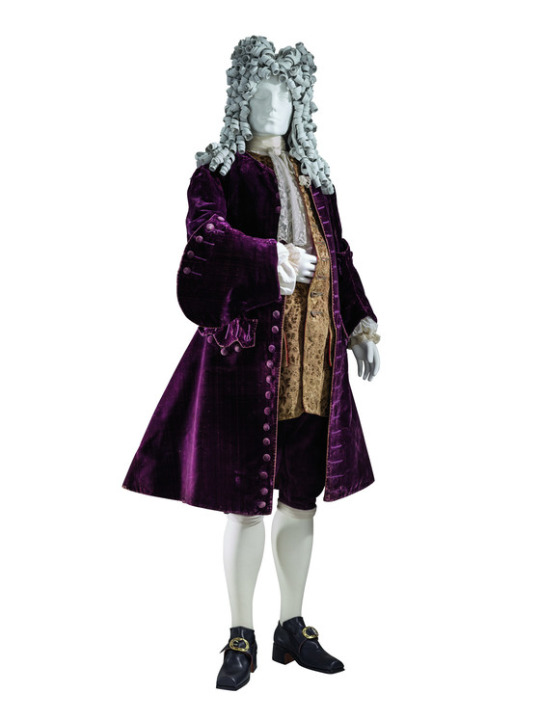
(1720's-30's, LACMA)
Embroidery designs are huge and chunky and often full of metallic threads, and the brocade designs even bigger.
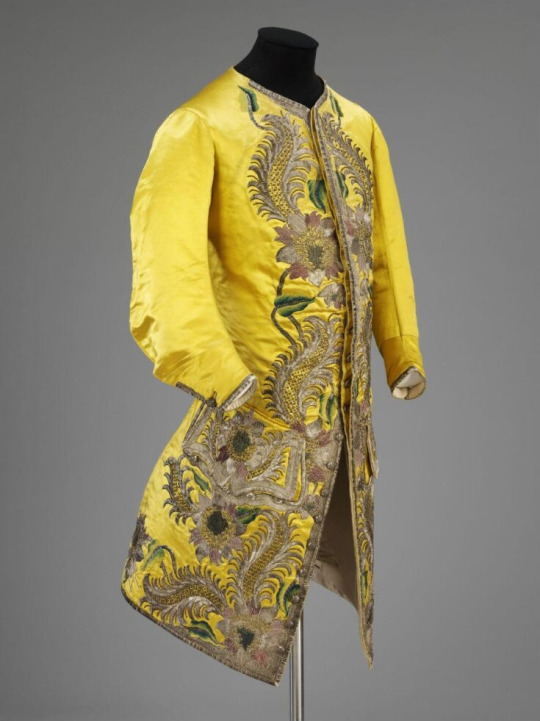
(1730's, V&A, metal and silk embroidery on silk satin.)
Sometimes they did this fun thing where the coat would have contrasting cuffs made from the same fabric as the waistcoat.
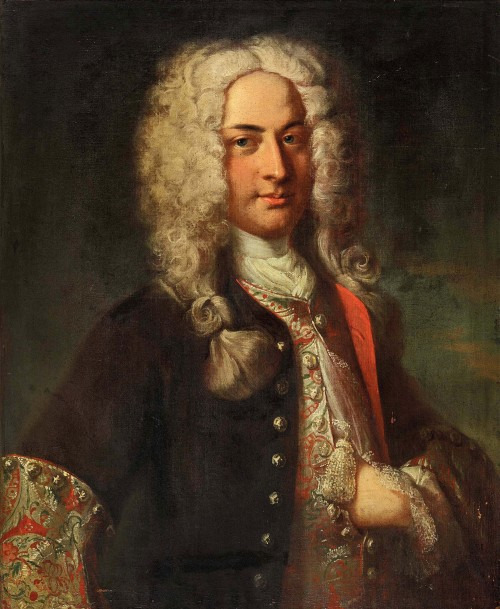
(Niklaus Sigmund Steiger by Johann Rudolf Huber, 1724.)
Tell me this look isn't positively made for vampires!
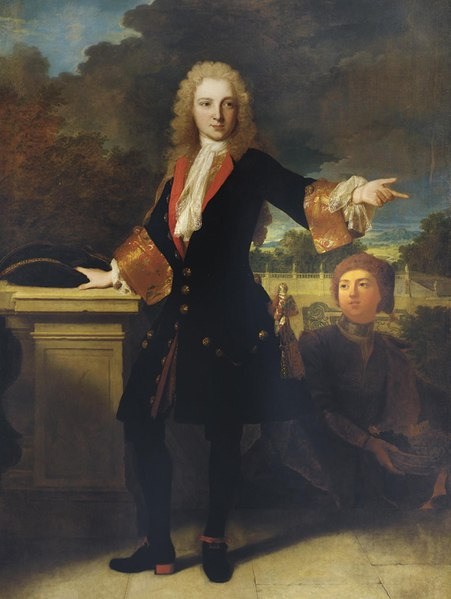
(Portrait of Jean-Baptiste de Roll-Montpellier, 1713.)
(Yeah I am cherry-picking mostly red and black examples for this post, and there are plenty of non-vampire-y looking images from this time, but you get the idea!)
And the wrappers (at-home robes) were also cut very large, and, if you could afford it, made with incredible brocades.
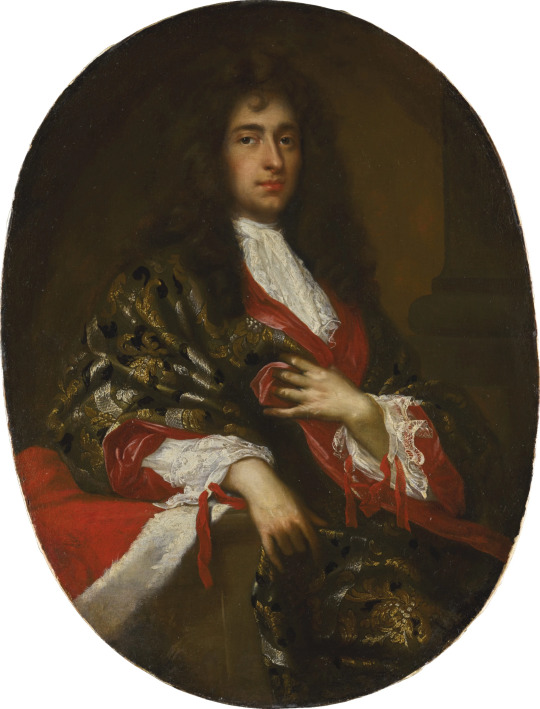
(Portrait of a nobleman by Giovanni Maria delle Piane, no date given but I'd guess maybe 1680's or 90's.)
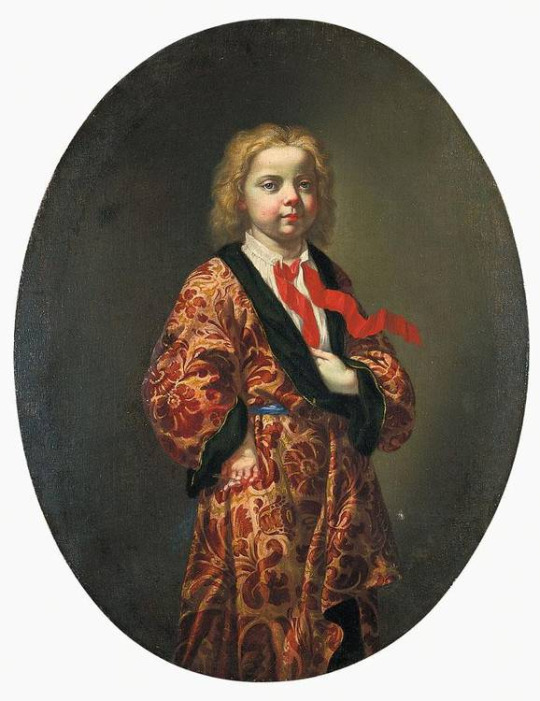
(Circle of Giovanni Maria delle Piane, no date given but I'd guess very late 17th or very early 18th century.)
Now that looks like a child who's been stuck at the same age for a hundred years if I ever saw one!
I don't know as much about the women's fashion from this era, but they had many equally large and elabourate things.
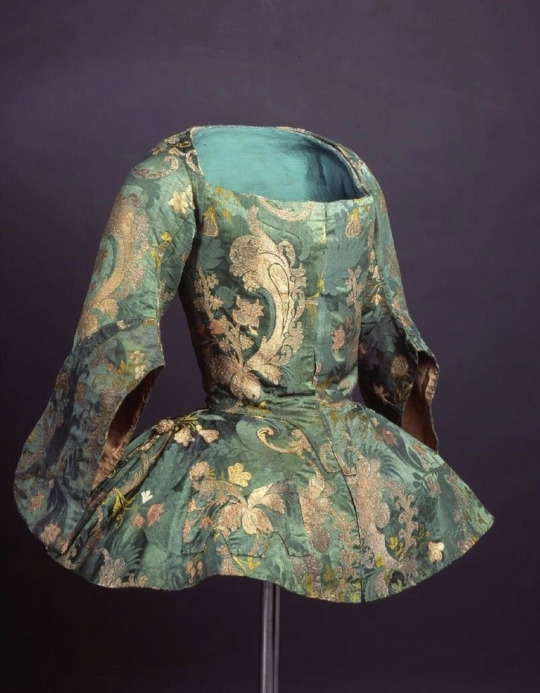
(1730's, Museo del Traje.)
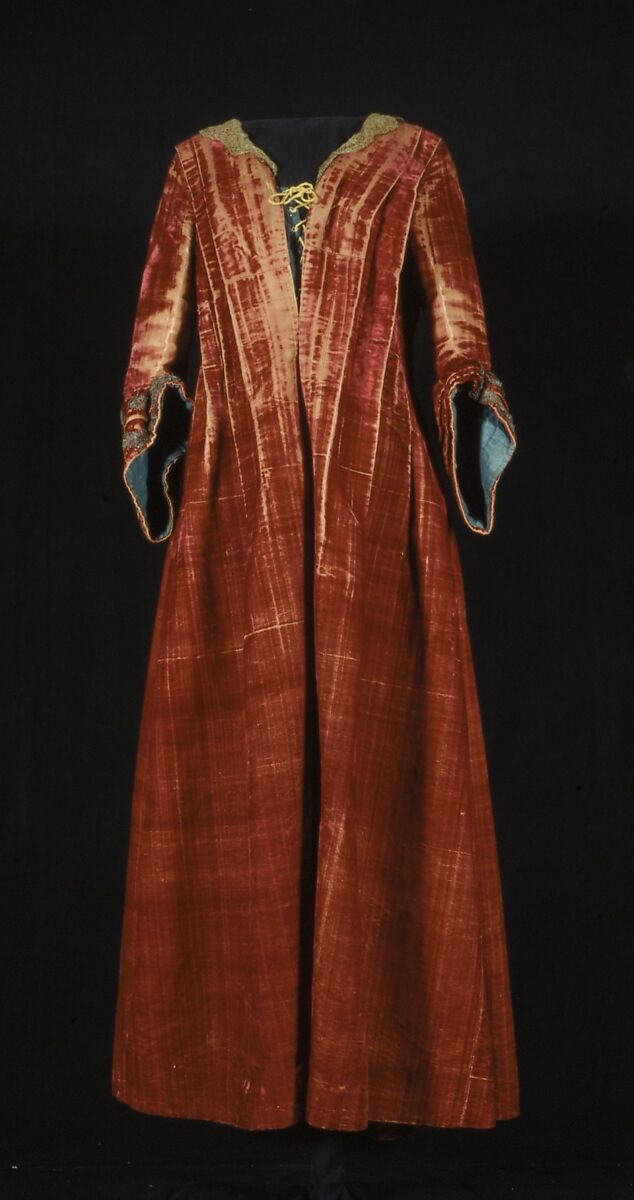
(Don't believe The Met's shitty dating, this is a robe volante from probably the 1720's.)
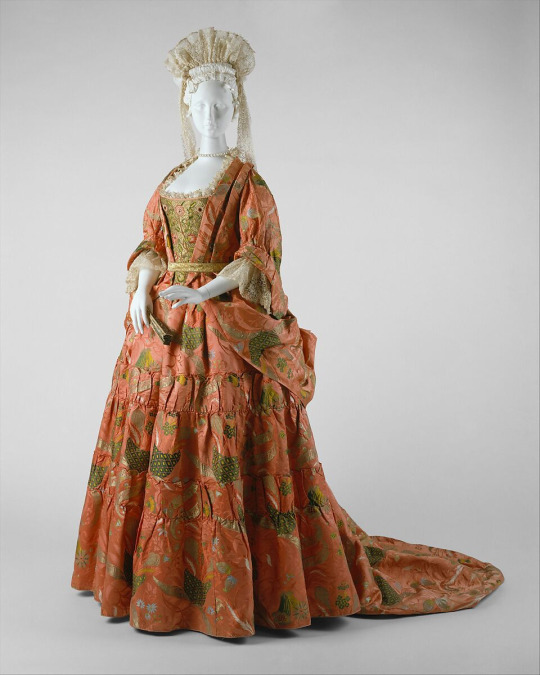

(Mantua, c. 1708, The Met. No idea why they had to be that specific when they get other things wrong by entire decades but ok.)
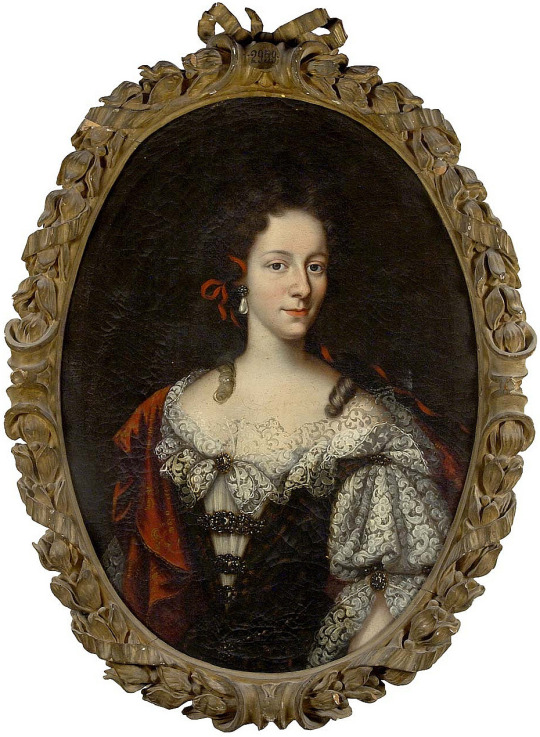
(Portrait of Duchess Colavit Piccolomini, 1690's.)

(Maria van Buttinga-van Berghuys by Hermannus Collenius, 1717.)
Sometimes they also had these cute little devil horn hair curls that came down on either side of the forehead.
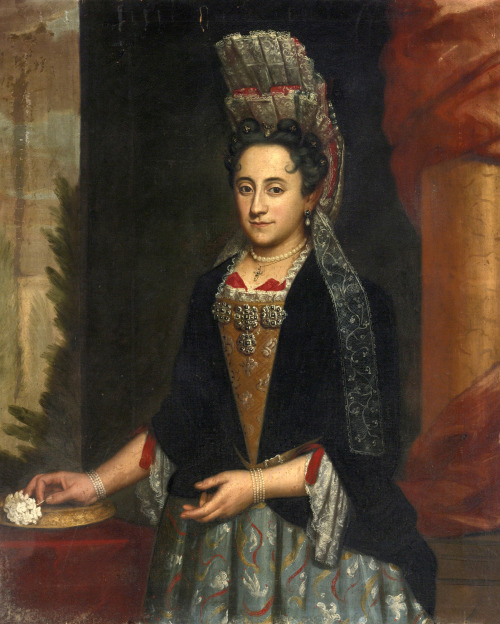
(Viago in drag Portrait of a lady, Italian School, c. 1690.)
Enough suave Victorian vampires, I want to see Baroque ones! With huge wigs and brocade coat cuffs so big they go past the elbow!
#long post#vampires#fashion#history#18th century#17th century#someday. SOMEDAY I will make a black/red/dark orange/metallic gold 1720's suit#I've got nearly all the materials I just need to:#1. Learn how to make early 18th century metallic thread buttons‚ preferably without having to buy the super expensive kind of thread#2. get a wig and style it appropriately
3K notes
·
View notes
Text
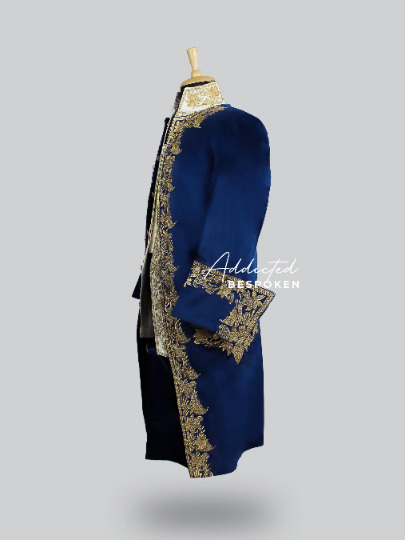
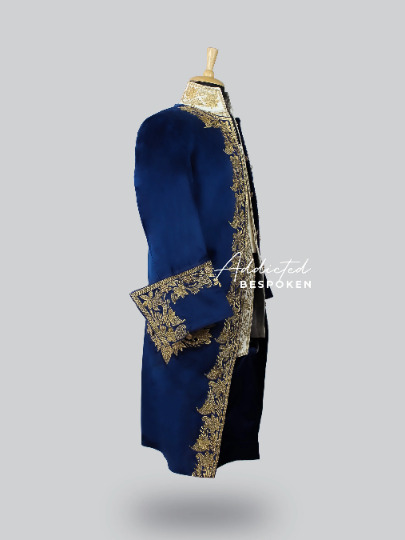

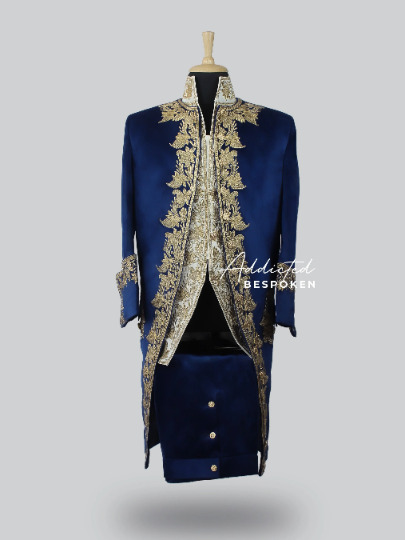

Men Blue Velvet 3pc French Nobleman Costume 18th Century Inspired Carnival Of Venice Rococo Wedding Outfit With Free Lace Jabots And Cuffs
This 18th Century vintage costume for men is inspired from the magical Venical Carnival & Late Baroque fashion. The costume can become the zest of any carnival or themed festival and can also be a perfect costume for wedding groom.
This 3Pc court suit include: •Blue velvet justaucorps embellished with paisley & floral embroidery & metal button detailing •Off white paisley print vest embellished with paisley & floral embroidery & have button closure •Blue velvet Breeches with floral embroidery on bottom & metal button detailings & closure •Laced jabots & cuffs
Features: •Intricate embroidered •Lightweight •Soft & Breathable •Comfortable wearing in all seasons
Material & Caring: •Premium Velvet & Eco friendly material •Dry Clean •Dry on low heat or hang to dry for best result
#Men's costume#18th century fashion#Late Baroque Fashion#French formal suits#Roccoco costume#Period costume#Rococo Suiut#Casanova costume#Noble Court Rococo#Colonial Outfit#Tudor costume#Court coat suit#Historical costume
5 notes
·
View notes
Text
My Fair Lady: Late Baroque Era Set

(no fancy thumbnail this time, sorry) ♫ < baroque music
Please READ ALL OF THIS before downloading. I will not answer an ask if it was answered here. Read.
This is a late 17th-century/early 18th-century Baroque Set. You will get 25 items for women, girls, and toddlers! Towards the bottom, I will give you tips to start a Baroque Era Save (people to find on gallery and men/boy attire).
I would like to thank @the-melancholy-maiden @linzlu @sychik @batsfromwesteros @vintagesimstress @cringeborg @acanthus-sims @stereo-91 and sims 2 creator maya40 for the stuff I've used to make all of this. I'm sure there are more creators but I cannot recall their names off the top of my head. DM me if you see a piece of your mesh here so I can give proper credit. I would also like to thank @belleophile for testing these items for me.
The stuff in this set can work for the late 1660s-early 1710s.
WHAT YOU GET: You will get 3 hat hairs, 1 for each age I listed above, 2 Fontanges for adults that work with the hat slider mod, 4 adult hairs, an adult baroque hair comb piece, 1 adult baroque sash accessory used for court and portraits, 1 ribbon hair piece to go with a hair, and 13 dresses (2 1670s/1660s mantuas, 1 1680s-1710s Habit used for Hunting or Riding, 1 1690s-1710s court dress used for court occasions, 1 1690s-1710s jeweled portrait dress and 1 1660s-1670s portrait dress with sash, and finally 7 1690s-1710s mantuas used for everyday, formal, and seasonal wear. I've included 1 dress for a child and 1 dress for a toddler as well).
SMALL NOTICE ABOUT THE PIECES: The hairline on the hairs will not behave correctly if you have head shape presets on the sim. I've tried fixing that but no luck. If I manage to fix it, I will update it. The Hat Hairs are found in the HAT category and are not compatible with hairs you MUST download the hair files that I'll be including with them. This being said, if you remove sim clothing while they have the hat hair on, it removes the hair override too. It's strange, but just put the hat back on and it should fix. The comb, and ribbon accessory are also found in the hat category. The Sash is found in the GLASSES category. The 1660s-1670s Mantuas are not compatible with shoes, leggings, or socks. I've removed these options in CAS tools so you shouldn't have to worry about clipping. The Barbara 1670s Dress has a sash meshed onto it, and because of this does not behave well with bigger bodies. The same applies to the Henrietta 1670s Dress, as the pearls don't behave with bigger bodies. Same with the Sarah 1670s Dress jewels. The 1690s-1710s Mantuas will have small gaps if the sim is plus-sized. I have tried to fix these issues, but no luck. The hat hair fontange looks a bit gray without reshade or a lighting mod. @northernsiberiawinds has some good lighting mods. Other than that, it's fine. Below, is how it will look white with a lighting mod.

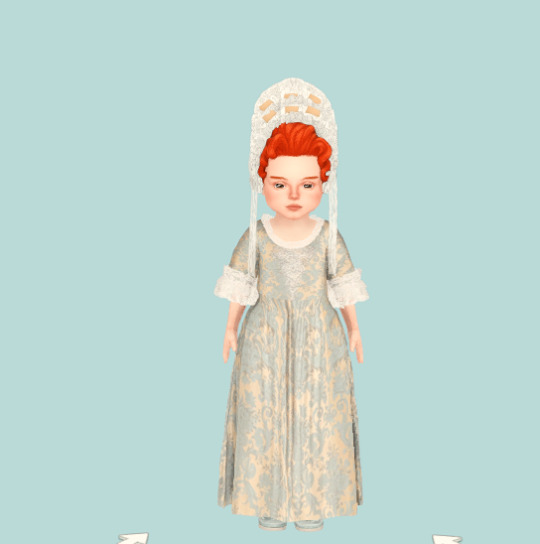
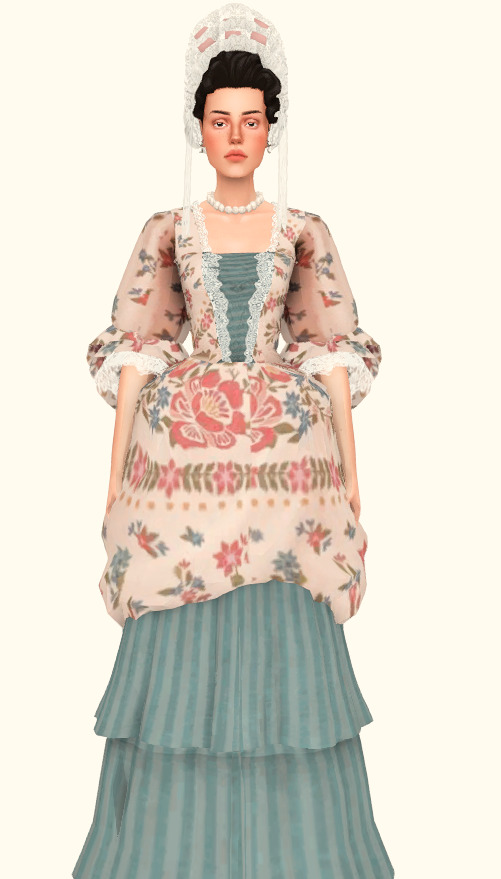
Everything has AT LEAST 20 swatches. Some things have more. There are only a few things that don't have this many swatches.
Here are some pics up close of what you are getting.
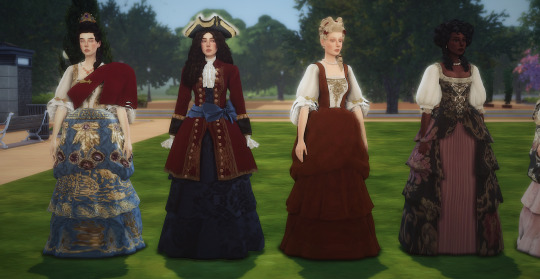
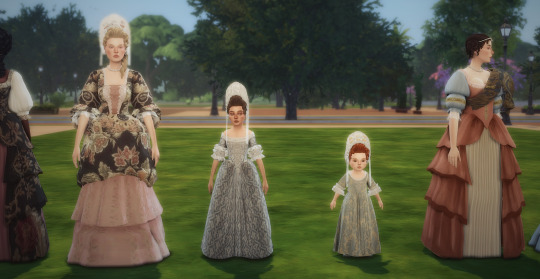
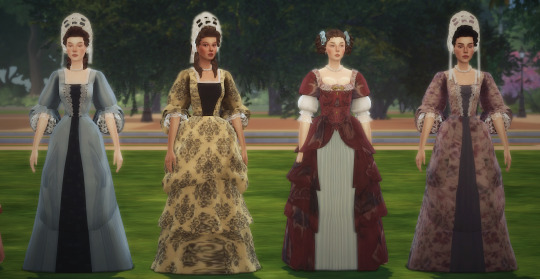
Here are some pics/fashion plates from this era.
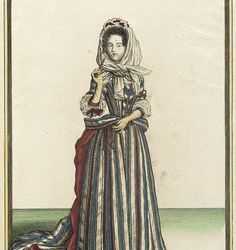

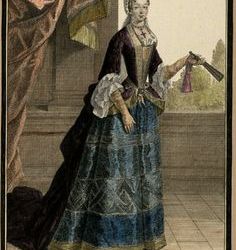

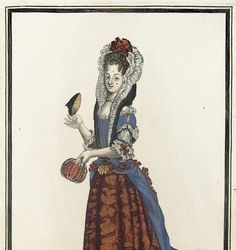
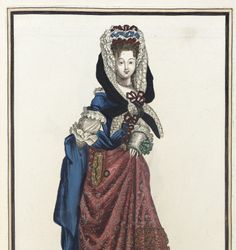
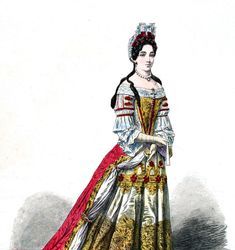
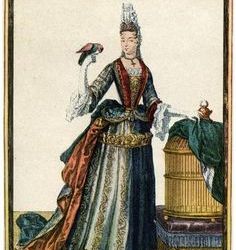
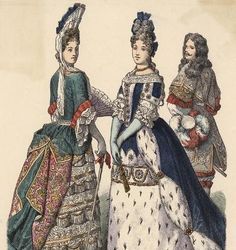
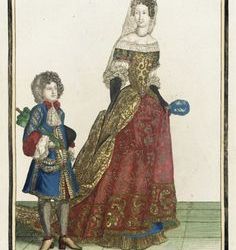
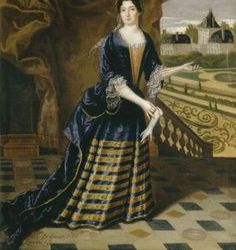
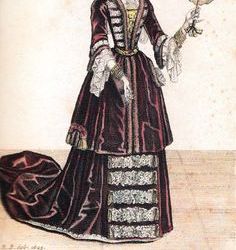
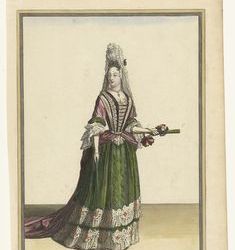


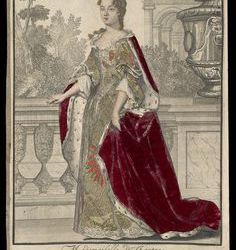
Did I forget the 1680s mantua..? Oh no! Luckily, I've included this surprise 1680s dress you'll be getting as well for reading all of that. So 26 items! (here you can see hat hair fontange without lighting mods installed)
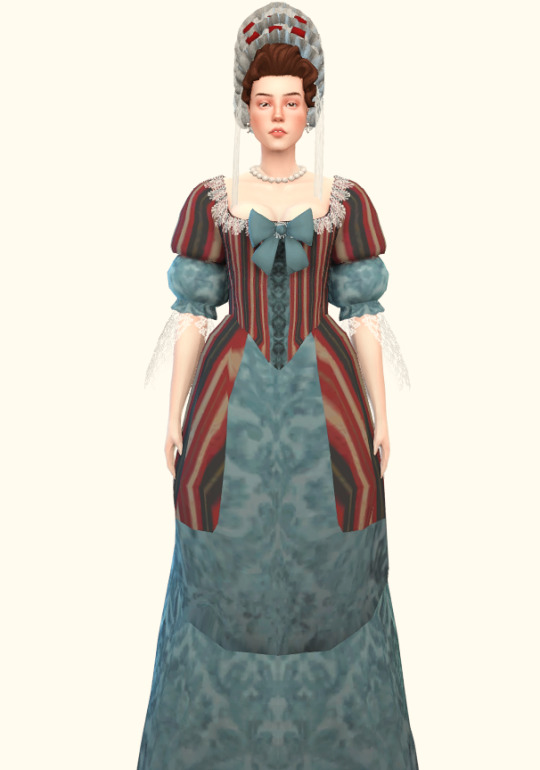
BAROQUE SAVE TIPS: These dresses will work for winter, summer, and traveling wear. Just add a fichu for summer wear or a shawl. For winter wear just add some long gloves and a cape. For men's stuff from this era, @stereo-91 has recolored some acanthus outfits which can be found here. I'll show you how they look below. I also recommend going to his gallery (ROTAMETERS91) as he has AMAZING builds for this era. For a little boy, @acanthus-sims has some stuff that can work.
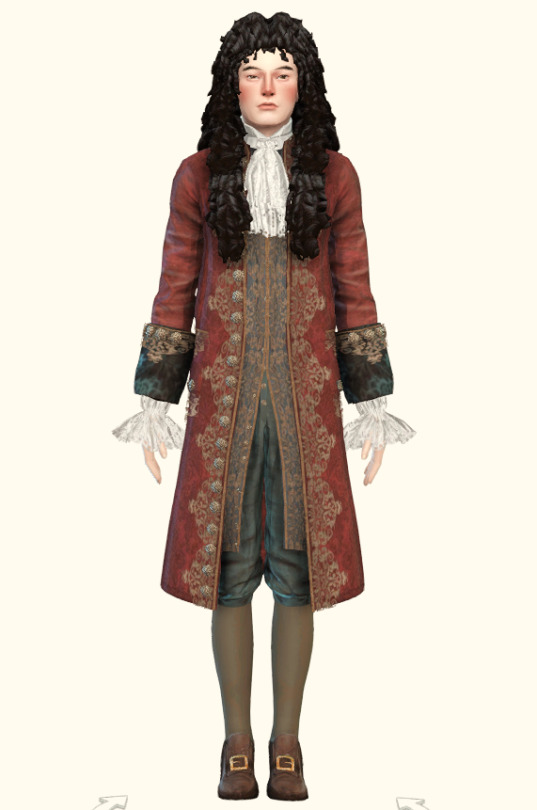
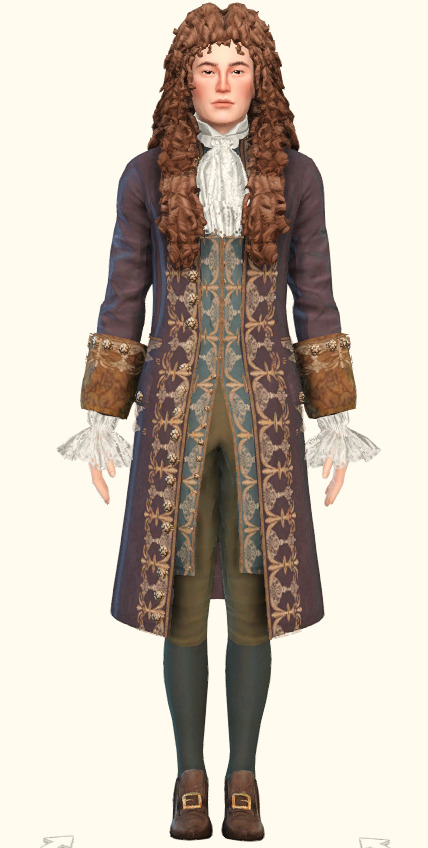
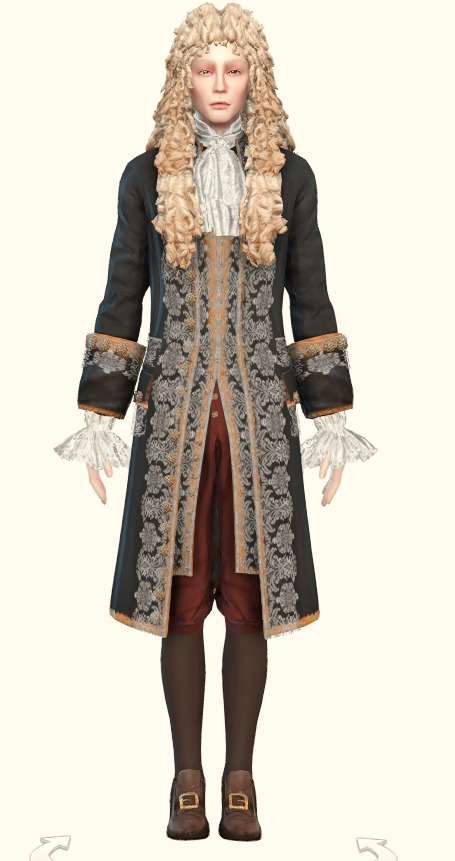

DOWNLOAD
#baroque ts4#baroque sims 4#sims 4 baroque#sims 4 decades#my cc#historical cc#ts4 cc#historical sims 4#sims 4 historical#historical sims#sims 4 cc#the sims cc
598 notes
·
View notes
Note
What kind of clothes would Vasco wear after Machete's death? He tends to wear bright and warm colors, and I was wondering if he would start wearing dark and cool colors to reflect his inner state
I also had thought that he might start to veer towards more somber shades. In reality, late 16th century fashion was dominated by dark colors, if you look at portraits from late renaissance/early baroque eras you quickly notice that pitch black was the most fashionable color (compare that to early and high renaissance fashion from 1400 to 1550 which was visibly more vibrant and colorful). I might be bending the timeline a little bit by having him dress in vivid blues with gold accents, but it's his signature style and I think it mirrors his luminous, free-spirited and approachable personality well. After Machete's death he might've experienced a period where jewel tones had lost their luster to him.
#answered#anonymous#Vaschete lore#I just like giving them distinct color schemes#Machete's secretary/assistant Vittorio favors black and dark grey but has an occasional glint of olive green#his personal physician Frosini has sort of a warm but muted palette#the former mentor priest/bishop Giordano is an ascetic guy so he's largely monochrome black and white#but with purple/magenta accents (compare to Machete's red)#Ludovica is green and reddish orange#and I haven't made up my mind about her partner's wardrobe but I have a few ideas#also been thinking of Vasco's twin sisters#this information is entirely meaningless but it's something I like to think about#makes them seem more like individuals#plus I love colors I love colorful things
215 notes
·
View notes
Text
Hi pookies!
On this account, I’ll be talking about Visual Kei, its history, and popular bands! 🎤🎸
(I’m new to this app, soo a lot of things are still a bit confusing for me 🙏🏻) There's not much info about Visual Kei online, and it’s often hard to find, so if I can help anyone interested in this topic, I'd be super happy !! ᕦ༼✩ل͜✩༽ᕤ
!!
Before We Begin: I apologize for any spelling mistakes, as English isn’t my first language. 🙇♀️
This post will include: What Visual Kei is, Visual Kei genres, and information about Visual Kei bands.
Okay class, first lesson!! (≧▽≦)
What is Visual Kei?
Visual Kei (Vkei) is a music and fashion subculture that originated in Japan. The term "visual style" refers to a concept that involves not just music but also dramatic stage costumes, makeup, and overall aesthetics. It was popularized in the late 1980s and early 1990s by bands like X Japan.
1. Visuals: Vkei artists often dress in androgynous styles that challenge gender norms. Expect colorful hair, exaggerated costumes, dramatic makeup, and theatrical accessories!
2. Music Genre: Vkei bands generally blend rock and metal influences with other genres like punk, pop, gothic, etc.
3. Performance: Stage performances are theatrical, often focusing on storytelling and creating a dramatic atmosphere.
Sub-genres:
1. Eroguro Kei (Erotic-Grotesque Kei):
Features: As the name suggests, Eroguro Kei combines erotic and grotesque elements. It is known for its dark and disturbing aesthetic. Costumes are often scary, vampiric, or horror-themed. Stage performances frequently include images of fear, death, and taboo subjects.
Examples: Some periods of Malice Mizer and the early years of Dir En Grey(visual kei era) MAYBE close to this style.
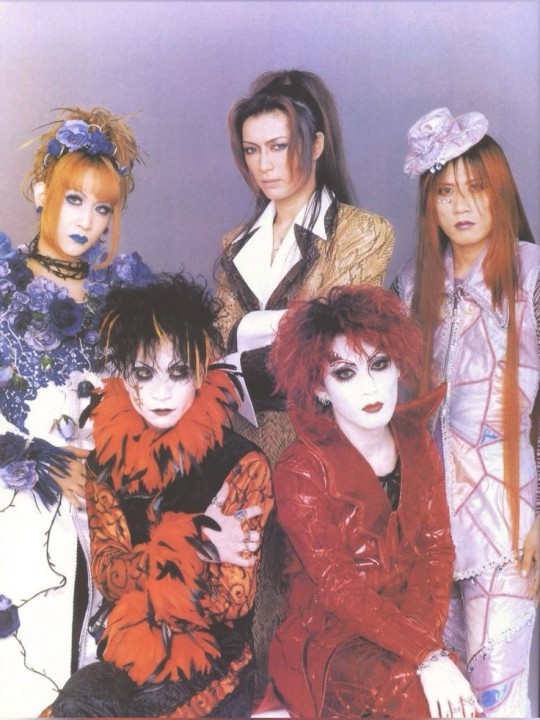
Malice Mizer ☆
Genre: Gothic Rock, Baroque Pop
Active Years: 1992 - 2001
About:
Known for their gothic and theatrical style, the band pushed visual elements to the extreme. The era with Gackt as the vocalist is particularly famous. Iconic songs include "Beast of Blood" and "Bel Air."
Career Summary:
Malice Mizer debuted in 1992, creating a legacy with their gothic, baroque, and theatrical approach. Over their career, they went through three different vocalists, each bringing unique styles. Their most famous era was with Gackt as the vocalist (1995–1999). After the death of drummer Kami in 1999, the band eventually disbanded in 2001. Despite their short lifespan, they are considered one of the most iconic Visual Kei bands.
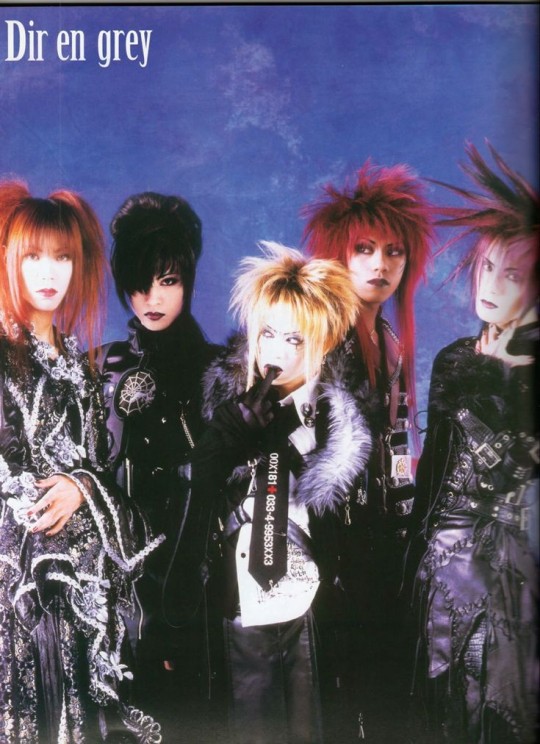
Dir en Grey
Genre: Alternative Metal, Progressive Rock
Active Years: 1997 - present
About:
With a darker and more experimental sound, the band has transcended the boundaries of Visual Kei, gaining an international fan base. Songs like "Obscure" and "The Final" have had a massive impact on the Visual Kei scene.
Career Summary:
Starting in 1997 as a more traditional Visual Kei band, Dir en Grey quickly evolved into a group with a darker, more experimental sound. They have toured extensively in Europe and the US, building a global fan base. Albums like "Withering to Death" and "Uroboros" showcase their transition into alternative and progressive metal, solidifying their status as an innovative force in rock music.
2. Kote Kei:
Features: Kote Kei represents the traditional and classic style of Visual Kei. In this subgenre, stage performances and costumes are usually darker and more serious. Black, red, and metallic colors are typically prominent. The fashion consists of costumes that combine both masculine and feminine elements, often with gothic touches.
Examples: X Japan and early Luna Sea can be considered examples of this style.

X Japan
Genre: Heavy Metal, Progressive Rock
Active Years: 1982 - present (with breaks)
About:
Pioneers of Visual Kei and one of the most influential bands in introducing this subculture to the world.
Career Summary:
Formed in 1982 by Yoshiki and Toshi, X Japan is considered the pioneer of the Visual Kei movement. They gained immense popularity in the late 1980s and early 1990s with albums like "Blue Blood" and "Jealousy." After disbanding in 1997, the band reunited in 2007, continuing to perform globally. Their iconic song "Endless Rain" remains a Visual Kei anthem.
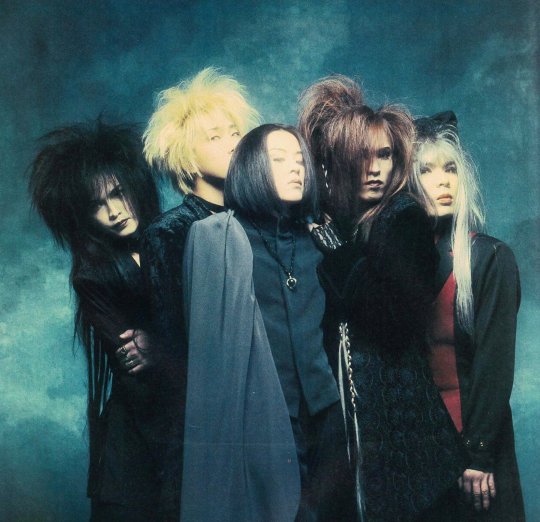
Luna Sea ✷
Genre: Rock, Progressive Rock
Active Years: 1989 - present
About:
One of the most influential bands in the Japanese rock scene, known for their softer and more melodic sound. Popular tracks include "Rosier" and "I for You."
Career Summary:
Formed in 1989, Luna Sea became a key figure in the Visual Kei scene. Their music blends melodic rock with progressive elements. They disbanded in 2000 but reunited in 2010 and have since continued to release new music and tour. Albums like "Mother" and "Shine" are iconic in their discography, and they remain a favorite in Japan's rock history.
3. Oshare Kei:
Features: Oshare Kei is the more cheerful, colorful, and energetic side of Visual Kei. In this subgenre, the clothing is generally in pastel tones, stylish, fun, and sometimes "kawaii" (cute). The music is lighter, energetic, and sometimes contains pop-rock elements. The stage performances focus more on fun than visual aesthetics.
Examples: Bands like An Cafe and SCREW can be considered examples of this subgenre.

An Cafe
Genre: Oshare Kei, Pop Rock
Active Years: 2003 - 2019 (with breaks)
About:
An Cafe (Antic Cafe) is one of the most well-known Oshare Kei bands, famous for their colorful and cheerful style. Their songs are often fun, energetic, and positive. Fans of the group are called "Cafekko."
Career Summary:
An Cafe debuted in 2003 and became a leader of the Oshare Kei movement in the mid-2000s. After a hiatus in 2010, they returned in 2012 but announced their disbandment in 2019, concluding with a farewell tour.
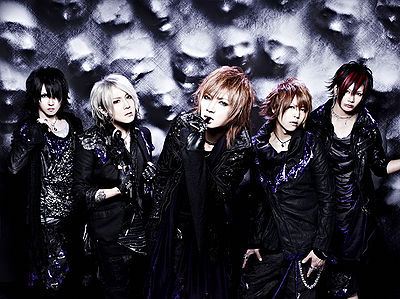
SCREW
Genre: Oshare Kei, Alternative Metal, Visual Kei
Active Years: 2006 - 2019
About:
SCREW is one of the heavier and darker Oshare Kei bands. Their music features emotionally intense lyrics combined with powerful riffs and melodic elements.
Career Summary:
Founded in 2006 by Byou and Jin, SCREW became a prominent name in the Visual Kei scene during the early 2010s. They disbanded in 2019 after 13 years.
4. Angura Kei:
Features: Angura Kei is a subgenre deeply connected to Japanese culture. This style blends traditional Japanese clothing (such as kimonos, samurai attire, etc.) with modern Vkei aesthetics. It is often inspired by Japanese history and culture.
Examples: Kagrra, and some older songs by PSYCHIC LOVER can be examples of this style.

Kagrra
Genre: Angura Kei, Neo-Japanese Rock
Active Years: 2000 - 2011
About:
Kagrra, is a standout band in the Angura Kei subgenre. Their music blends traditional Japanese instruments and melodies with modern rock and Visual Kei aesthetics. Their lyrics often draw inspiration from Japanese mythology, folklore, and history. Stage costumes frequently incorporate traditional Japanese styles like kimono and samurai themes.
Career Summary:
Debuting in 2000 as "CROW," they soon changed their name to "Kagrra,." The band disbanded in 2011, releasing their final album, "Hyakki Kenran." Tragically, vocalist Isshi passed away the same year. The group is considered a pioneer in fusing Japanese culture with modern music.

PSYCHIC LOVER
Genre: Rock, Anisong (Anime Songs), Angura Kei
Active Years: 1998 - present
About:
PSYCHIC LOVER is a well-known name in Japan’s anisong scene, particularly for their work on anime and tokusatsu (Japanese sci-fi series) themes. They combine traditional Angura Kei aesthetics with the energy of anisong. Their music is often high-tempo, with powerful vocals and energetic guitar riffs.
Career Summary:
The band rose quickly in the anisong scene in the early 2000s, gaining a dedicated fan base through their work on anime, Super Sentai, and tokusatsu projects. Their stage performances are dynamic and occasionally incorporate Japanese cultural elements in costumes and music videos, nodding to the Angura Kei style.
!!!
Each Vkei subgenre offers a different world in terms of both music and visuals. Simply labeling it as a "gothic stage" is an oversimplification. ☝🏻🤓
We’ve reached the end (╥﹏╥)
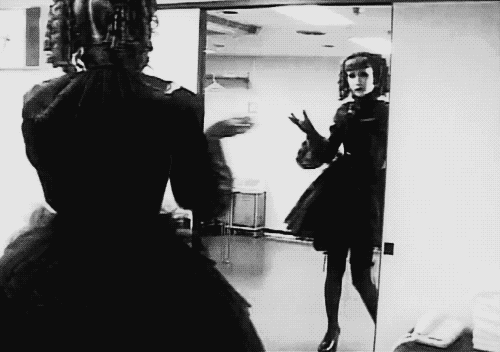
I’m finishing here. Honestlyy, if it were up to me, I’d write until morning, but I’m not sure if this will really reach people, so I don’t want to write for no reason. I’ll continue based on the interaction I get. If you have any questions, feel free to reach out to me.
I wish you all healthy days. ♡
Written by: manaberrysoup
#music#malice mizer#goth aesthetic#ouji fashion#ouji lolita#gothic#heavy metal#x japan#anime#goth#mana sama#band music#black metal#japan#jpop#jrockband#jrock#visual kei#kei#jpop idol#jrock icons#an cafe#transgender#oshare kei#luna sea#kote kei#eroguro#androgynous#japanese idol#metal
48 notes
·
View notes